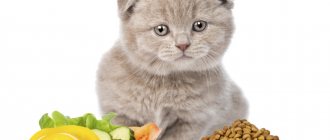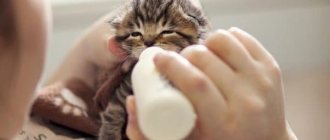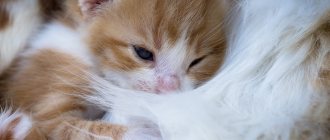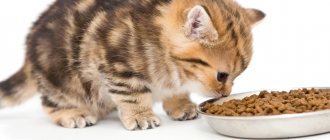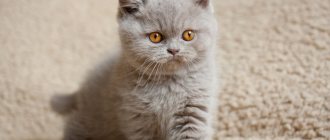Many people, having adopted a small fluffy ball, do not know how to feed a one-month-old kitten without a cat, how to play with it and care for it. Of course, the best option for a new pet is mother’s milk, and any more or less knowledgeable person will tell you that you cannot separate an animal from its mother at such a young age.
A kitten at 1 month is not yet strong enough to live independently, its immunity is still too weak, and most of the habits that ensure the healthy functioning of the baby must be instilled by the mother cat. But cases in which the question of what to feed kittens without a cat becomes relevant still happen, and there is a need to feed the baby with your own efforts. Well, let's look at the rules for feeding a one-month-old kitten and find out all the useful information regarding this issue, taking into account the nuances, including the safety of the health and life of the little creature.
Feeding rules
To feed a kitten for 1 month, according to all the canons, you must adhere to the following rules:
- do not feed your baby minced meat;
- add vitamins to the kitten’s diet;
- do not give poultry meat until the baby begins to chew beef meat;
- To control your pet’s reaction to unfamiliar foods, new food should be introduced gradually, one food per day.
If you need to accustom your baby to dry food, do it as follows: soak a small amount of food in boiled water. Then spread the resulting porridge across the kitten’s palate. Repeat this procedure several times, soaking the food a little less each time. Repeat the procedure until the pet begins to chew the food on its own.
Dairy products
For a kitten, the lifespan of one month is not enough and, like any baby, it needs milk formula. To compensate for the need for this healthy product, boiled milk with a small amount of honey (a small spoon per glass is enough). If we talk about priorities when choosing a dairy product, then it is better to choose cream (fat content 8%). If possible, it would also be nice if you pamper your baby with goat’s milk or some fermented milk product:
- fermented baked milk;
- kefir;
- yogurt and so on.
Solid foods
Solid foods like porridge and cheese should be introduced into the diet of a 1-month-old kitten little by little and gradually. Be sure to give your baby plenty of water. It is best if you take semolina porridge as the basis for solid nutrition.
Then you can add a little cottage cheese to it. After this, the kitten can be treated to a boiled egg, but not all of it, just the yolk. The egg should be given a couple of times a week. It will be better if you knead it first, rather than feed the baby in pieces. The same applies to the subsequent product - meat and fish. They should also be cut into small strips. You can also mix any solid product with porridge. According to the rules of feeding, fish should be given to a kitten no more than once every 5-7 days, but it is better to boil it or cut it very finely. It is not recommended to give salted and smoked fish to kittens one month old.
Place vegetables and fruits as a separate item.
Vitamins and fiber
The baby can and should be fed foods containing many vitamins:
- apples;
- cucumbers;
- all kinds of greens.
In order for your pet to successfully cope with the offered treat, the product will need to be grated. Once a week you can feed your baby soup without any seasonings. It makes sense to give vegetables and fruits only occasionally - 1-2 times a week and a little at a time.
In general, these are the main provisions regarding what to feed kittens without a cat. If you follow at least some recommendations and give your baby vitamins, your pet will develop in the right direction and delight you with good health and a good appetite.
Breast milk substitutes
You can feed a newborn kitten without a cat using special substitutes. Every owner of a pregnant cat should familiarize themselves with the types of cat milk substitutes in advance and be prepared to supplement their babies if something happens.
The main composition of milk from a lactating cat is practically no different from other types. The difference lies in the ratio of substances. So, cat milk contains about 70% water and 11% fat. This means that cat milk has much lower fat content than human milk, goat milk, and especially cow milk.
The protein content in normal cat milk is also about 12%, but lactose is no more than 3%. Each type of milk, regardless of whose origin it is, is suitable for a specific animal.
It is not possible to completely replace cat milk with other dairy products, but in some cases it is necessary. Thus, a cat's milk substitute must necessarily contain vitamin and mineral complexes, as well as the amino acid taurine and polyunsaturated fatty acids.
For artificial feeding of kittens, special mixtures are produced by companies that produce granulated ready-made food. They differ from each other in quality and useful elements. Often professional breeders use the following brands to feed kittens:
- Dr.Clauder's Kitten Milch;
- Canina Katzenmilch;
- Royal Canin Babycat Milk;
- Beaphar Kitty Milk.
The cost of real cat milk substitutes is quite high, so some owners are thinking about what can replace the dry formula. Veterinary experts do not recommend doing this yourself, but in some cases you can use simple recipes.
You can replace cat milk with high-quality condensed milk 20%, which does not contain water and sugar. For 2 week old kittens, you can mix condensed milk with meat and bone meal. For older kids, you can mix whole cow's milk with the yolk of a chicken egg with added sugar. Vitamin drops are also added to this mixture. It is recommended to consult a veterinarian regarding the exact dosage. Z
replace cat milk with infant formula, stirring according to instructions, followed by dilution 1:1.5.
Feeding 3-week-old babies can be done from a bottle with a nipple, but newborn babies in the absence of a pronounced sucking reflex can be given the mixture using a pipette or a disposable syringe without a needle. The mixture must be introduced gradually so that the kitten has time to swallow a portion of milk and does not choke.
Before each feeding, you need to warm up the milk mixture to a temperature of 37-38 degrees. It is not advisable to store the finished milk mixture in the refrigerator for a long time, but to prepare a new one each time. This will preserve all nutrients and prevent the possibility of developing a bacterial infection.
How to teach a one-month-old kitten to eat on its own?
So we touched on one of the main issues regarding the care of a one-month-old kitten - how and when you need to teach it to eat on its own and the time it will take to complete this procedure. Typically, a kitten begins to show interest in the saucer at three weeks of age. At this time, he is more interested in the process of eating food by adult animals than in the food itself.
But in any case, three weeks of age is the best period to start teaching a kitten to eat on its own.
You should start with milk. To do this, you need to pour milk into the cat's saucer, then dip your finger in it and let the baby lick it. The cub will quickly understand that this is a very tasty treat and will reach for the bowl. After this, the kitten can already poke its muzzle into the milk, but the main thing is not to overdo it, otherwise the baby may get scared or choke. After the kitten licks its face several times, you can try to give it freedom of movement. Most likely, the pet will reach for the saucer itself and after a short hitch, nature will take its toll and he will begin to lap. If the attempt is unsuccessful the first time, the procedure should be repeated.
At first, the baby may snort and even sneeze - this is normal, because he is just learning. The kitten can also get carried away and climb its paws right into the cup; such moments need to be stopped and the animal returned to a normal position for eating. To do this, remove the baby's limbs from the saucer and wipe them. If the situation repeats, hold the animal, letting it know that this cannot be done. Then such incidents will stop.
Be attentive and patient with your little animal, and within a few days the kitten will begin to eat on its own. In general, age is not of fundamental importance in this matter; the most important thing here is to show patience and diligence. When the kitten begins to feed itself, do not rush to stuff it with raw meat and potatoes. After all, a kitten’s nutrition from 1 to 3 months should be planned taking into account its unformed body, and for better results it is better to give the pet the opportunity to gradually learn about food other than milk.
Vitamins
Natural cat milk contains all the vitamins a kitten needs. But artificial mixtures are not always able to satisfy all the needs of a growing organism. A lack of vitamins, in turn, can lead to vitamin deficiency, which, in turn, leads to decreased activity, loss of animal beauty and vulnerability to infectious diseases.
That is why the owner should carefully ensure that all the necessary microelements enter the body of small pets.
Particularly important vitamins are:
- A-group. These vitamins are necessary to maintain immunity, cell renewal and growth, and normal vision;
- B vitamins influence almost all vital processes. They are needed for the good functioning of the gastrointestinal tract, nervous system, musculoskeletal system, vascular and heart function, as well as the development of muscle tissue;
- Vitamin C takes an active part in metabolism, stimulates the immune system, helps the absorption of various mineral compounds, and helps ensure the body’s protective functions;
- Vitamin D promotes the absorption of phosphorus and calcium. This microelement is simply necessary for the normal growth of teeth, claws and bones;
- Vitamin E is an antioxidant that fights free radicals. Also, this substance plays an important role in the formation and development of the reproductive system;
- K is a vitamin responsible for blood clotting and the process of hematopoiesis.
Diet of one-month-old kittens
Which diet is better for a one-month-old kitten – dry food or natural food? This is a complex question, and in cat breeder circles there have been serious debates about the benefits of a certain type of feeding for many years.
Of course, if we take as a basis the food in which the manufacturer has included everything that the baby needs for health: vitamins, microelements and other useful additives, then it will be nice if you feed a month-old kitten with just such food. In addition, the owner of the animal is freed from many conventions that appear among people who feed their baby homemade food. And from the point of view of veterinarians, balanced feeding is useful for the full development of the pet. But is dry food suitable for your kitten, and does it contain everything that the manufacturer promises? Yes, maybe you just raised more than one generation of kittens on healthy homemade food, and don’t trust suspicious dry bits. Situations are different, so we will analyze both options, and you will choose which one is right for your kitten yourself. But whatever the outcome, you should remember the basic important rules:
- Let's call the first rule “either-or”. It means that if you start feeding a month-old kitten with natural products, then you do not need to add dry food to its diet. After all, different foods are digested differently. In addition, a kitten consuming dry food drinks much more liquid than a pet eating exclusively natural products. Therefore, if you want to protect your animal from troubles like gastroenteritis, coprostasis and other gastrointestinal troubles, then follow the first rule.
- Next, is it possible to feed a one-month-old kitten different foods? It’s better not. If you have chosen a certain brand of food for your baby, then stick with it. After all, each brand has its own distinctive features and certain components. If food is mixed or changed, then there is a high risk that the kitten will get certain problems associated with calcium levels or, for example, a strange picture of amino acids. Digestive problems are also possible.
- The last basic rule is to buy the right food. There is no need for your child to take a mass-market product. These foods are akin to fast food and all these inexpensive, bright labels will not bring anything good to the baby. Buy premium kitten food, or even better, super-premium. Your pet will definitely be grateful for food of this level.
Natural food
If you want your kitten to be accustomed to natural food, you should adhere to certain conditions:
- The diet should be varied. If you do not accustom your animal to certain foods from an early age, then it will hardly be possible to do this with age. For this reason, try to diversify your baby’s food, offer different things - this will help make the baby an omnivore, will not turn him into a picky creature and will help ensure adequate nutrition.
- Do not feed your pet kibble from your table. First of all, you run a great risk of raising an eternally meowing beggar, and secondly, this can harm the kitten, because human food contains a lot of spices and salt that are harmful to the young body.
What to feed a one-month-old kitten, besides the primary product - milk? You can feed the baby cottage cheese. Only at first it is better to stir it with milk until it reaches a consistency similar to sour cream. Cottage cheese is a good source of calcium, which helps prevent the development of rickets.
The next product is chicken yolk (boiled egg white can be given from 2 months). First, it also needs to be mixed with milk. The following products will also benefit your kitten:
- porridge with meat and milk broth;
- boiled vegetables;
- neutral (no spices) broth soups.
True, not every kitten will enthusiastically attack such food. After all, although it is a month old, it is a predator. Meat products can be any kind. The basic rule is that the meat should not be fatty and any product for the kitten must first be boiled and then chopped. Meat is cooked not for ease of eating, but in order to prevent various diseases and infection of the pet with helminths.
The kitten grows quite rapidly, so its body requires a sufficient amount of minerals and vitamins. By consuming regular food, the baby does not always receive the required amount of nutrients in full. Therefore, it would not be superfluous to add special vitamin complexes to your pet’s food, which can be purchased at any store that sells pet products. There are sufficient quantities of drugs of this kind on the market and you can always choose something for your pet. You can also grow various useful herbs, for example, sprout wheat.
As already mentioned, diversify your diet. It is not advisable to feed the animal only meat or only fish, or even only porridge. By the way, you don’t need to give fish often. It has been proven that frequent consumption of fish leads to inflammatory kidney diseases. And if over time you decide to castrate the animal, then it is better to completely exclude fish from the menu. The kitten's nutrition should be close to natural conditions, this also applies to temperature conditions. Do not give cold (from the freezer) or excessively hot foods. Pet food is not salted.
Remember that the baby must have access to water. This is especially important if the animal eats dry food, because in this case, water consumption increases several times compared to normal conditions. The water should be fresh and clean, change it daily, and rinse the empty bowl with hot water or scald with boiling water.
Ready-made food for one-month-old kittens
Many different brands have gained popularity in the cat food market:
- Hill's Science Plan;
- from Eukanuba Junior Small Breed;
- Royal canin size nutrition mini junior and many others.
Let's look at a few specific examples from the super-premium cat food segment.
- Royal Canin dry food for kittens
You should always remember that the premium class is the best food among the worst representatives of products of this type. And if the prefix “super” is not present on the packaging, this is already a compelling argument to doubt the quality of the food presented. But you still need to be more objective. Let's first talk about the benefits of Royal Canin for kittens:
- affordable pricing policy;
- wide variety of tastes;
- accessibility for the buyer;
- veterinary line.
You can now see the current price of kitten food and buy it right here from Yandex Market with fast delivery:
- The next representative is Akana super-premium food for kittens.
Acana offers food in three flavor categories: lamb, chicken, fish.
If we consider the advantages, Akana is characterized by the following positive qualities:
- a balanced diet;
- lack of grain crops in the product;
- no chemical dye.
The main disadvantages are a small variety of tastes and no preventive diets.
- Almo Nature 1 month kitten food is also worthy of mention.
The origins of the popularity of the food lie in triple checking of the quality of the product and the naturalness of the ingredients. In general, Almo Nature food is close in overall quality to VIP class food. Indeed, in this Italian diet, chicken meat (as the basis of the product) and its derivatives occupy 53% of the total weight of the product. Another 14% goes to the share of non-allergenic rice.
The main disadvantage of the presented product is its rather high price.
Introduction of complementary foods
It is recommended to start introducing natural food when the kitten reaches 2 weeks of age. The following will work great for these purposes:
- meat pates;
- porridges cooked with milk and broth;
- egg white;
- cottage cheese;
- kefir and fermented baked milk;
- meat and vegetable mixtures.
If you want to transfer the kitten to a commercial diet, ready-made food at the age of 2-3 weeks, he is allowed to offer pates, jellies, mousses - semi-moist and wet food. It is recommended to soak dry food for kittens in water or milk for a while so that it acquires a softer consistency, similar to oatmeal.
What should you not feed a one-month-old kitten?
You need to pay great attention to the nutritional options and standards for a small pet. After all, this is not an adult animal with an established organism and its digestive organs are still in the development stage. Keep in mind that a lot depends on how correctly you feed your baby - even his life, so every caring owner should understand this.
Milk and meat
As for milk, it is better to take goat or dry milk, sold in specialized stores for animals. If we take dairy products as the basis of nutrition, then products with a low fat content are better suited for the animal.
You should not feed your pet raw meat; it contains worms and pathogens. And the baby’s body will not cope well with such rough food.
Monotonous food
The kitten does not need to be fed monotonous foods. For example, give one fish or one cereal. This feeding option leads to the fact that the baby will receive an insufficient amount of useful minerals. Also, if a one-month-old kitten is not accustomed to a variety of cuisines, in the future he will become very picky, which will cause certain difficulties.
Food from the table
The kitten does not need to be fed food from the table. It contains a lot of spices that are unnatural for the baby’s body. It is harmful to give sausage and various smoked meats, and it does not matter what is included in their composition. The same applies to pickles, because all these products can be called food for people, containing excess fats, salt and other ingredients.
You can't give potatoes. And this applies to root vegetables in general. It doesn’t matter whether the tuber is raw, boiled or fried, remember - a kitten’s stomach does not digest potatoes.
Fatty food
A small pet does not need any food containing a lot of fat. Therefore, it is better not to give such foods as cheese, butter, fatty meat at first, but to feed the baby gradually.
- Bones (bird, fish) are another harm for the cat family in general.
- Pork - this type of meat is completely unnecessary for kittens; it is not only useless, but also poses a potential threat.
- Any food for dogs and puppies is not suitable for a baby kitten. They contain completely different components that are required for the full growth of the baby.
- It is better not to give your pet sweets or rich yeast rolls.
- Don't forget one rule - you can't feed your kitten different foods and mix natural food and ready-made food.
Can a cat take kittens back?
There can be a lot of answers to the question of why a cat refuses to feed its cubs:
- The mother cat developed complications after giving birth;
- The animal considers the baby unviable (the so-called fading kitten syndrome);
- There are too many kittens or the cat herself has little milk;
- The mother has a hormonal imbalance;
- The animal does not have enough nutrition (does not eat enough) or the content of microelements, vitamins and other useful substances in it is insufficient.
So what to do if the cat does not feed newborns? Alas, there is nothing left but for the owner to do it himself. For no reason or at the behest of the soul, a cat will never refuse to care for its offspring. Therefore, it is better to try to prevent such a situation than to try to correct it later.
Feeding regimen and norm
If you do not take into account the feeding regime, then you can figure out how many times you need to feed a kitten for 1 month on your own. To do this, you need to pay attention to how the baby behaves. A hungry animal begins to squeak and squirm, showing dissatisfaction with its entire appearance. Such a kitten must be fed according to certain standards. And one-month-old babies, left without maternal care, need to follow a certain diet. How many times should a one-month-old kitten be fed?
Feeding regimen for one-month-old kittens:
- A baby up to two weeks should be fed 7 times a day. Moreover, night time is also taken into account. Ideally, all 10 feeding sessions should be divided into equal periods of time.
- Kittens living from two weeks to a month need food 6 times a day under similar conditions.
- A kitten 1 month and older can be fed 5-6 times a day in small portions.
How much food should a one-month-old kitten be given:
- From a week to two, the recommended rate is 30 ml per 100 grams of weight.
- From two to three weeks the norm increases from 38 to 48 ml.
- A kitten from a month old should be given food in the amount of 48-53 ml for the same 100 grams of weight.
Kittens weight gain
A kitten's weight gain is an important indicator of its health, growth and development. On average, a kitten should gain 10 g per day; kittens of large breeds (Maine Coon, Norwegian cat and others) can gain 15 g per day.
The kitten should be weighed every day until the age of 2 weeks, from 2 to 4 weeks - once every 3 days, then you can switch to weekly weighing until the end of the kitten's growth period. The weight of a kitten, as well as the rate at which it gains, depends on the expected weight of an adult animal, which is determined by its gender or breed.
Table: kitten body weight depending on its age
| Kitten age | Body mass |
| at birth | 60–160 g |
| 1 Week | 110–260 g |
| 2 weeks | 140–360 g |
| 3 weeks | 200–600 g |
| 4 weeks | 240–750 g |
| 2 months | 400–1700 g |
| 3 months | 1.0–2.5 kg |
| 4 months | 1.7–3.9 kg |
| 5 months | 2.2–5.5 kg |
| 6 months | 2.3–6.0 kg |
| 7 months | 2.4–6.5 kg |
| 8 months | 2.5–6.9 kg |
| 9 months | 2.5–7.0 kg |
| 10 months | 2.5–7.7 kg |
| 11 months | 2.5–8 kg |
| 12 months | 2.5–9 kg |
| Adult animal | 2.5–10 kg |
Kitten 1 month care and feeding
Caring for a one-month-old kitten requires a special approach and care. You have already figured out what to feed your baby, but in addition to food, the baby needs care and warmth. Remember that caring for a small pet is comparable to caring for a small human child. The animal needs to be fed the right food and done regularly.
In this case, you need to give your pet some freedom. Let him get used to the house and gradually explore it. And if you love stroking and want to pat your baby, do it with tenderness and very carefully.
Water
When feeding with formula milk, the body may not need water. When reaching 10-12 days, you should fill the bottle with clean water and offer it to the kitten between feedings. At the age of 15-20 days, you should install a saucer and “show” the kitten the water, lightly pushing it with its muzzle into it. Then nature will take its course.
A source of water must be constantly located so that the animal can drink without obstacles.
Using these tips, you can try to feed a kitten and raise a healthy and strong animal.




